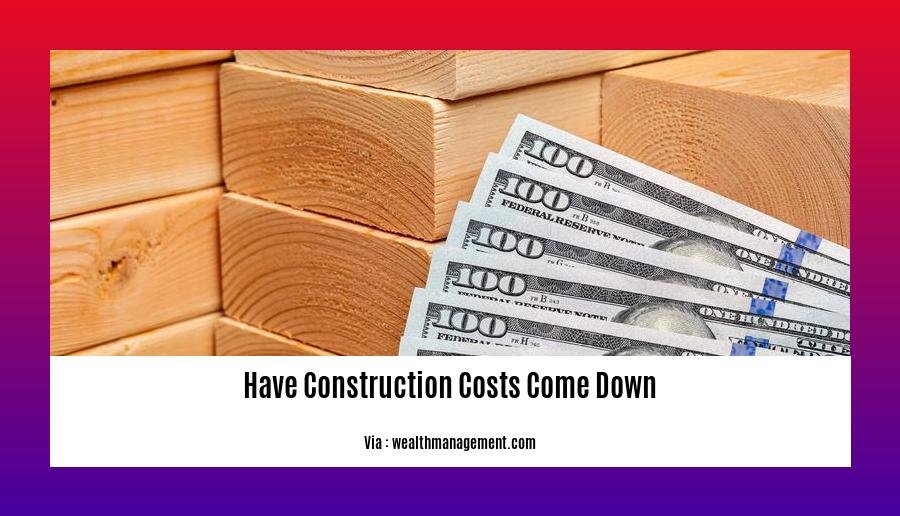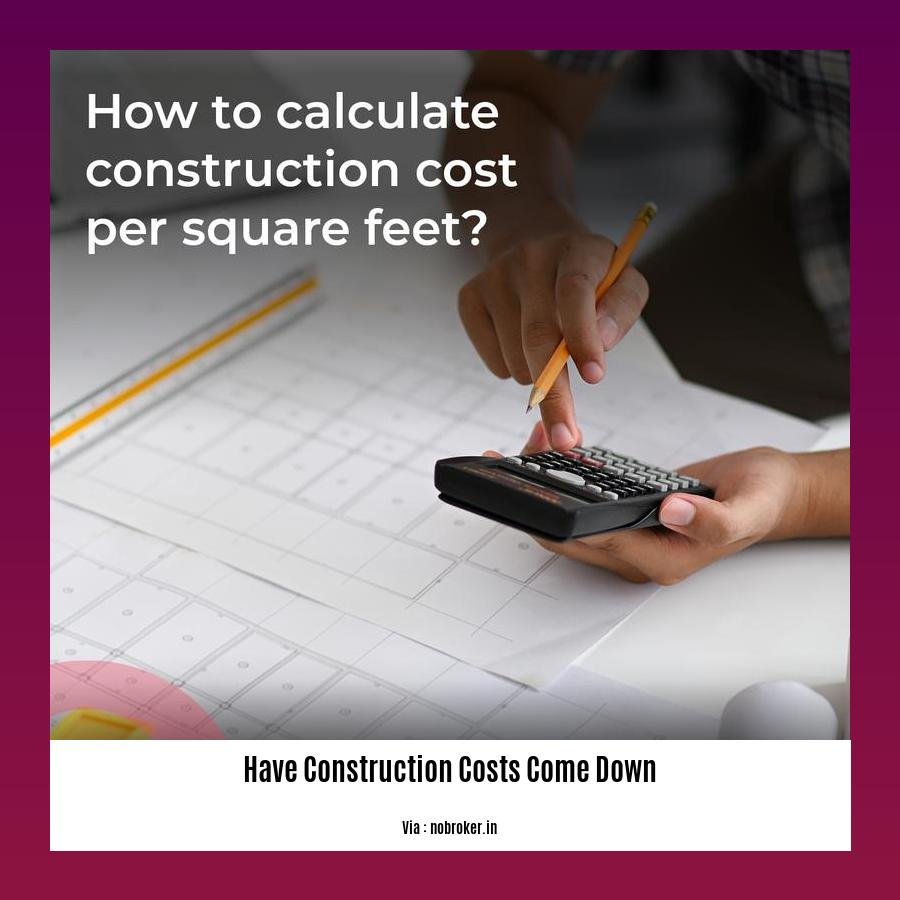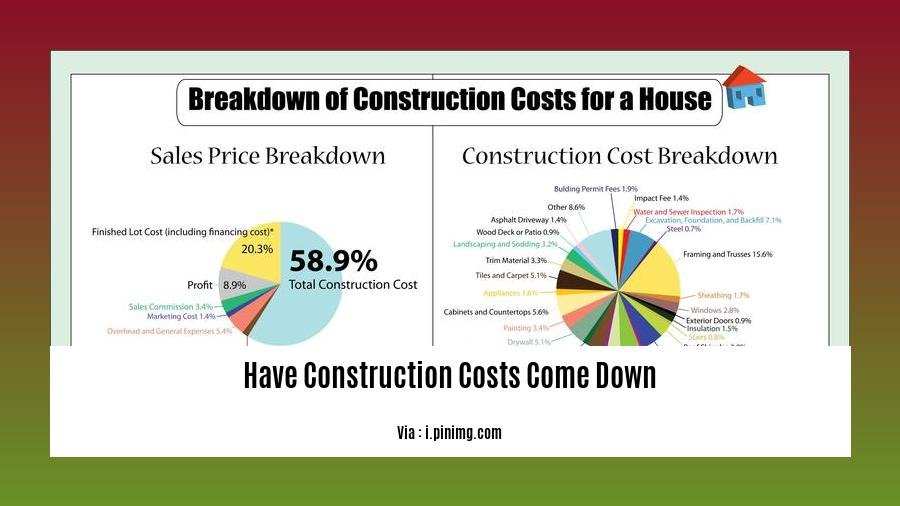**Have Construction Costs Come Down? An In-Depth Analysis**
Key Takeaways:
- Construction costs experienced an unprecedented 17.5% surge from 2020 to 2021, surpassing all such rises since 1970.
- Costs in 2021 soared 23% beyond pre-pandemic levels of 2019.
- Escalating material costs (steel, lumber, concrete) are the primary drivers of the construction cost increase.
- Experts at the National Association of Home Builders foresee a potential dip in construction costs by 2024, contingent on an expected economic recovery.
Have Construction Costs Come Down?

With inflation continuing to squeeze household budgets, understanding the dynamics of construction costs has become more critical than ever. Have construction costs come down? It’s a question on many minds.
While construction costs skyrocketed in 2021, reaching a peak of 23% above pre-pandemic levels, recent data suggests a gradual decline. The National Association of Home Builders (NAHB) forecasts further decreases in 2024, driven by an anticipated economic recovery.
Factors Influencing Construction Costs
The surge in construction costs over the past few years was primarily fueled by rising material costs. Steel, lumber, and concrete prices have all soared, driven by supply chain disruptions, increased demand, and geopolitical factors. Labor shortages have also contributed to higher construction expenses.
Signs of a Slowdown
However, there are signs that the construction cost curve may be flattening. In recent months, lumber prices have fallen significantly, and the price of other materials, such as steel, has stabilized. Additionally, labor shortages are easing as the unemployment rate drops.
Impact on Consumers
Have construction costs come down enough to make a meaningful impact on consumers? While costs are still elevated compared to pre-pandemic levels, the moderation in recent months provides some relief. For those considering home renovations or new construction projects, it’s important to stay informed about market trends and adjust budgets accordingly.
Steps to Mitigate Costs
Despite the recent cost declines, construction expenses remain high. If you’re planning a construction project, consider the following steps to mitigate costs:
- Plan ahead: Start planning your project early to allow for material availability and contractor scheduling.
- Shop around: Compare bids from multiple contractors to secure the best price.
- Consider alternatives: Explore cost-effective materials and design options without sacrificing quality.
- Hire experienced contractors: Choose contractors with a proven track record of efficiency and expertise.
- Manage the project effectively: Stay organized, communicate clearly, and monitor progress to minimize delays and overruns.
Conclusion
Whether construction costs have come down is a complex question with a nuanced answer. While costs remain elevated compared to pre-pandemic levels, there are signs of a gradual decline. By carefully planning projects, shopping around, and utilizing cost-effective strategies, consumers can navigate the current construction market and achieve their building goals.
Radiation therapy can leave you with surgical options to restore your breast form, similar to a breast augmentation. To learn more about breast reconstruction after radiation therapy, visit our webpage.
Finding a good reviews for construction company shouldn’t be hard.
Assessment of regional variations in construction costs

Region plays a powerful role in shaping construction costs. But what factors drive these local variations?
Key Takeaways:
- Labor costs: Wages vary significantly depending on local economies and availability of skilled labor.
- Material prices: Transportation costs and local supply chains impact the availability and cost of materials.
- Building codes and regulations: Local building codes and permit requirements can influence construction methods and materials used.
- Land prices: The value of land, particularly in urban areas, can have a major impact on project costs.
- Competition: The level of competition among contractors and suppliers can affect pricing and availability of services.
Regional Factors at Play:
Understanding these factors allows for a more accurate assessment of construction costs in specific regions:
- High-growth regions with strong economies often have higher labor costs but also greater access to skilled workers.
- Coastal regions may face higher material costs due to transportation expenses.
- Metropolitan areas with strict building codes may result in increased construction costs.
By considering regional variations, construction professionals can better estimate project expenses, negotiate contracts, and make informed decisions throughout the building process.
Citation:
– Comparative analysis of regional construction labor cost determinants
Government policies and Incentives Influencing Construction C
Outlook for future construction cost trajectory
Key Takeaways:
- Construction costs remained elevated in 2023 due to inflation, high mortgage rates, and persistent material costs.
- Predictions for 2024 vary, with some forecasting potential decreases and others expecting a recovery.
- Factors influencing construction costs include the economic landscape, interest rates, inflation, and market demand.
- Technological advancements and sustainable building practices may drive cost savings and efficiency in the construction sector.
Navigating the future of construction costs can be a tricky task, but by understanding the factors that influence them, you can make more informed decisions about your project. Whether costs continue to rise or start to decline, the construction industry is constantly evolving, so it’s important to stay up-to-date on the latest trends.
What are the factors that influence construction costs?
A multitude of factors can affect construction costs, and some of the most important ones include:
- Economic landscape: The overall health of the economy can have a big impact on construction costs. When the economy is strong, businesses and consumers are more likely to invest in construction projects, which can drive up prices. Conversely, when the economy is weak, construction activity may slow down, leading to lower prices.
- Interest rates: Interest rates can also affect construction costs. When interest rates are high, it becomes more expensive for businesses to borrow money to finance construction projects. This can lead to lower construction activity and lower prices.
- Inflation: Inflation is another factor that can affect construction costs. When inflation is high, the cost of materials and labor increases, which can lead to higher construction costs.
- Market demand: The demand for construction services can also affect construction costs. When demand is high, prices tend to be higher. Conversely, when demand is low, prices tend to be lower.
What is the outlook for future construction costs?
The outlook for future construction costs is uncertain. Some experts predict that costs will continue to rise in 2024, while others believe that costs will start to decline. A number of factors will likely influence construction costs in the coming years, including the economic landscape, interest rates, inflation, and market demand.
Technological advancements and sustainable building practices may also play a role in future construction costs. As new technologies are developed, the cost of construction may decrease. Additionally, sustainable building practices can help to reduce energy costs and other expenses, which can also lead to lower construction costs.
Citations:
- Soho: Will Building Costs Go Down in 2024?
- Deloitte: 2024 Engineering and Construction Industry Outlook
FAQ
Q1: Have construction costs come down in 2023?
A1: In general, construction costs remained elevated in 2023 due to ongoing inflation, high mortgage rates, and persistent material costs.
Q2: What factors have been driving up construction costs?
A2: The primary factors contributing to increased construction costs include the rising prices of materials such as steel, lumber, and concrete, as well as labor shortages and supply chain disruptions.
Q3: Are construction costs expected to decrease in 2024?
A3: Predictions vary. Some organizations, like the National Association of Home Builders (NAHB), anticipate a potential decrease due to an expected economic recovery. However, other experts forecast a more gradual decline or even continued high costs.
Q4: What can be done to reduce construction costs?
A4: Several strategies can help reduce construction costs, such as optimizing project design, utilizing cost-effective materials, and implementing efficient construction methods. Technological advancements and sustainable building practices can also contribute to long-term cost savings.
Q5: How does the economic landscape impact construction costs?
A5: Economic conditions significantly influence construction costs. Factors such as inflation, interest rates, market demand, and government policies can affect material prices, labor availability, and overall project expenses.
- Decorative Backsplash Ideas: Colorful Kitchen Transformations for Your Home - November 13, 2025
- Choosing Backsplash Materials: Ideas for Kitchen and Bathroom Designs - November 12, 2025
- Kitchen Backsplash Tile Patterns: Find Your Perfect Style - November 11, 2025










